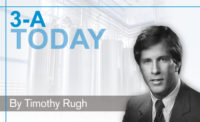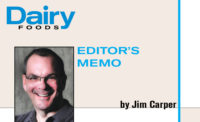Consumers shun fad diets; turn to a holistic approach to wellness

Many Americans find themselves in one of two categories: ditching their New Year’s resolutions or committing to a healthier lifestyle for the long haul. A look at the major food and drink trends occupying American dinner tables in 2015 tells the story of healthy lifestyles, “clean” ingredients, at-home gourmands, value consciousness and e-commerce specialty products.
At least that’s the view from Mintel, the Chicago-based market research agency. Dairy processors should take note of Mintel’s analysis as they develop and market milk, cheese, yogurt, ice cream and other dairy foods. Mintel’s Director of Innovation and Insight Lynn Dornblaser and Global Food and Drink Analyst Jenny Zegler identified the following five trends they say will affect the food and drink market in the United States this year.
1. It’s not a diet, it’s a lifestyle
Consumers are shunning restrictive fads in favor of a more holistic wellness approach. These more open-minded, health-conscious consumers are keeping an eye on the long-term, which makes them less fearful of the occasional splurge.
America’s battle with an expanding waistline continues. While 56% of U.S. consumers reference dieting in order to lose or maintain weight, most consumers prefer to count reps at the gym instead of calories (83%).
When it comes to dieting, high-protein diets are the nation’s favorite. Forty percent of consumers agree that food and drink products high in protein help them feel fuller longer, and 37% agree that protein assists with building muscle. In addition, the number of food and drink products launched with low/no/reduced fat, low/no/reduced sugar or low/no/reduced calorie claims decreased between 2013 and 2014, while the number of products with a high/added fiber claim or a high-protein claim has risen.
2. Clean is the new green
Rather than the relatively intangible claim of being “good for the environment,” the new priority is transparency. Consumers want to know more about ingredients, products and the companies that make and sell them.
Twenty-two percent of grocery consumers would like to see improved labeling on packaging to help them easily identify healthier food products, and less than 38% trust what companies say on labels. Currently 80% of consumers look for nutritional claims (i.e. vitamins, fiber) when buying food, while over one third (38%) look for products that are all natural. Food origin is also quickly becoming a purchase factor with 35% of consumers seeking out products that carry a local claim.
“Simply and effectively communicating benefits is essential for consumers and a big trend this year,” said Dornblaser. “While ‘local’ is a great buzzword, provenance lets consumers know where products originated. Additionally, ‘clean’, ‘simple’ and ‘real’ are all being used on labels to introduce natural, no additives or preservatives.”
3. Professional-grade foods
Consumers want to cook like celebrity chefs but, for the most part, they don’t know how. This is creating a market for products (at retail and for delivery) that cater to these aspiring gourmands by making home cooking easy, while still wholesome and high in quality.
Today, 26% of consumers claim to have advanced cooking skills (up from 20% in 2012) and 41% consider themselves to have intermediate skills.
“The rise of food-related television and media has inspired innovative home cooking in 2015. Consumers are embracing short-cuts that allow them to enjoy meal-time rather than ready-made substitutions,” said Dornblaser.
Meal kits, ingredient delivery services and other products that encourage home chefs to make recipes their own have a welcome audience. Brands provide online and mobile support to budding home cooks.
4. Death of the middle ground
Consumers are almost constantly redefining their definition of “value.” This ongoing search for good deals forces brands, as well as private labels, to choose between affordability or premium positioning.
Value will continue to drive consumer choice in 2015 as the influence of private-label products will be more noticeable. Between January and November 2014, 30% of food and drink launches were private label.
Consumers do not always associate private labels as store brands. In fact, a hefty 87% of consumers when tested got at least one store or name brand identification wrong, although just 13% say they have trouble differentiating branded from private label products. In addition, “value” does not always mean “inexpensive.” Products that are not cheap, but offer good value, also connect with consumers. Manufacturers will cater to consumers’ quests for value in 2015 by offering affordable options that also have added amenities.
5. Shopping the Internet
E-commerce is now shaking up food and drink retailing. The internet provides access to products from a range of companies that are designed to address specific dietary needs, personal interests and other distinct consumer needs. Purchasing groceries online is still more of an intrigue rather than a habit. Thirty-one percent of U.S. men age 18 to 34 have bought groceries online in the past 12 months and would do so again, while only 21% of women in that age group have done so.
Additionally, consumers don’t mind interacting with brands online when it comes to sharing their thoughts through contests, promotions or R&D.
“Despite the ubiquity of online shopping, U.S. consumers have yet to embrace e-commerce when it comes to the grocery lists,” said Zegler. “At least for the time being.”
Based on a press release from Mintel.
Americans see water as a healthy choice
While dairy processors struggle to sell milk, water bottlers are surfing a rising wave of consumption. A survey for the International Bottled Water Association, a trade group in Alexandria, Va., found that U.S. consumers see water as a smart beverage choice. They consider bottled water to be healthier than soft drinks.
The IBWA cited the Beverage Marketing Corp. which stated that bottled water is on course to become the No. 1 packaged beverage in America by 2016.
According to the online survey conducted in November 2014, 96% of Americans believe they should be drinking more water. The poll also found that 95% of Americans believe that bottled water is a healthier beverage choice than soft drinks. In what can only be considered bad news for milk processors, 55% of those surveyed said that bottled water was among their preferred beverage.
Looking for a reprint of this article?
From high-res PDFs to custom plaques, order your copy today!








